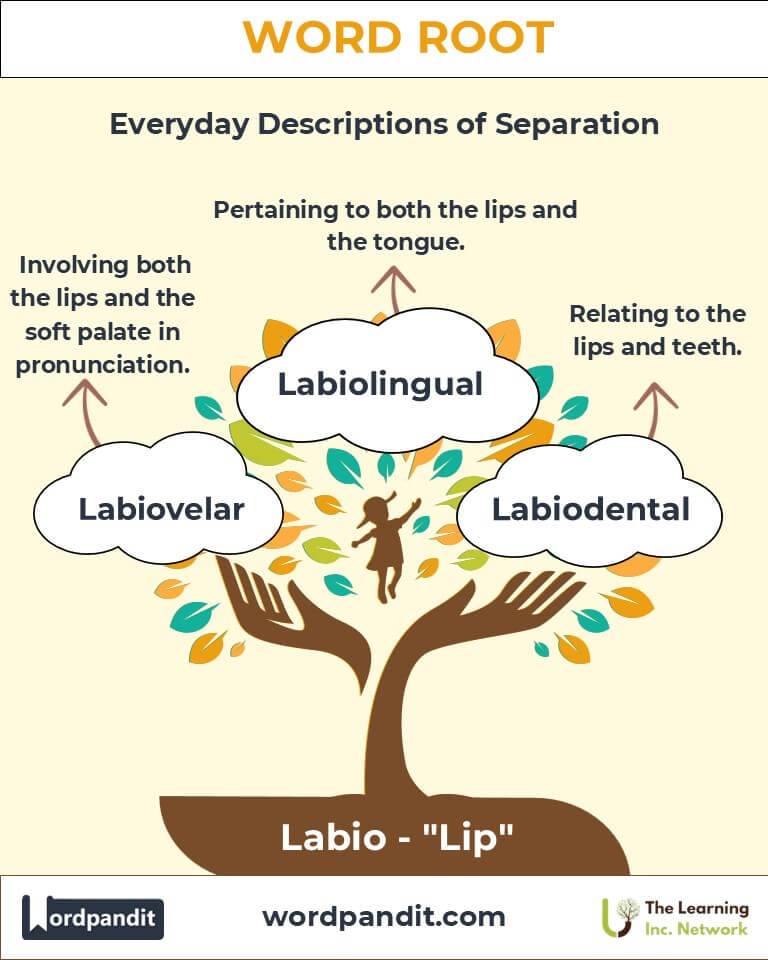Labio: The Root of Language, Sound, and Expression
Explore the linguistic and anatomical significance of the root "labio," derived from the Latin word for "lip." From labial sounds in linguistics to labiodental articulations in speech, "labio" reveals its profound role in communication, culture, and specialized fields.

Table of Contents
- Introduction: The Power of "Labio"
- Etymology and Historical Journey
- Mnemonic: Unlocking the Power of "Labio"
- Common Labio-Related Terms
- "Labio" Through Time
- "Labio" in Specialized Fields
- Illustrative Story: "Labio" in Action
- Cultural Significance of "Labio"
- The "Labio" Family Tree
- FAQs about the "Labio" Word Root
- Test Your Knowledge: "Labio" Mastery Quiz
- Conclusion: The Living Legacy of "Labio"
1. Introduction: The Power of "Labio"
The root "labio" is a linguistic gem, referring to the lips' critical role in articulation, anatomy, and expression. Pronounced "lay-bee-oh," this Latin root serves as the foundation for words related to speech sounds, such as "labial" (produced with the lips) and "labiodental" (involving both the lips and teeth). Its applications span fields like linguistics, phonetics, and medicine, emphasizing its importance in communication and beyond.

2. Etymology and Historical Journey
The root "labio" originates from the Latin word labium, meaning "lip." Ancient scholars used it to describe the lips' anatomical function in speech and their role in sound production. Over centuries, "labio" found its way into linguistic terminology, medical nomenclature, and cultural expressions, maintaining its relevance across disciplines.
3. Mnemonic: Unlocking the Power of "Labio"
Picture a smiling face with lips articulating words clearly. Now imagine the words "Labio loves to articulate language." This mnemonic ties "labio" to its association with sound production and communication.
4. Common Labio-Related Terms
- Labial (lay-bee-uhl): Relating to the lips.
Example: "The sound /p/ is a labial consonant because it is produced with the lips." - Labiodental (lay-bee-oh-den-tuhl): Relating to both the lips and teeth.
Example: "The /f/ sound in 'fun' is a labiodental fricative." - Bilabial (bye-lay-bee-uhl): A sound produced using both lips.
Example: "The /b/ in 'bat' is a bilabial plosive." - Infralabial (in-fra-lay-bee-uhl): Situated below the lips.
Example: "The infralabial region is often analyzed in facial studies." - Labionasal (lay-bee-oh-nay-zuhl): Pertaining to the lips and nasal cavity.
Example: "The /m/ sound in 'man' is a labionasal consonant."
5. "Labio" Through Time
- Historical Significance in Language:
- In ancient phonetics, "labio" described lip-based sounds in early Latin grammar texts.
- The introduction of "labiodental" in the 19th century refined the classification of sounds involving lips and teeth.
- Modern Developments: Advances in phonetics have emphasized "labio" in understanding regional accents and speech therapy.
6. "Labio" in Specialized Fields
- Linguistics and Phonetics: "Labial" and "labiodental" classify sounds essential for articulatory phonology.
- Anatomy and Medicine: Infralabial refers to specific areas of the face relevant in cosmetic surgery and dermatology.
- Music: Labial pipes in organs use lip vibrations to produce sound, showcasing "labio" in acoustics.
- Speech Therapy: Understanding labial and labiodental sounds aids in diagnosing and treating articulation disorders.
7. Illustrative Story: "Labio" in Action
In a bustling classroom, a speech therapist, Ms. Harper, taught children the difference between bilabial and labiodental sounds. Using playful exercises, she encouraged them to say "pop" (bilabial) and "fan" (labiodental). The children laughed and learned, mastering how their lips shaped words—a perfect demonstration of "labio" at work.
8. Cultural Significance of "Labio"
The lips symbolize communication, beauty, and emotion in many cultures. Phrases like "sealed with a kiss" highlight their expressive power. In linguistics, "labio" underscores the universality of lip-based sounds across languages, celebrating humanity's shared vocal capabilities.

9. The "Labio" Family Tree
- Lingua- (tongue):
Example: Lingual (related to the tongue). - Dent- (teeth):
Example: Dental (related to the teeth). - Phono- (sound):
Example: Phonetics (the study of speech sounds). - Nas- (nose):
Example: Nasal (related to the nose).
FAQs About the Labio Word Root
Q: What does "labio" mean?
A: "Labio" comes from the Latin root labium, meaning "lip." It refers to sounds or structures involving the lips, with applications in linguistics, anatomy, and phonetics.
Q: What is a labiodental sound?
A: A labiodental sound is produced using the lower lip and upper teeth. Examples include the /f/ sound in "fun" and the /v/ sound in "van," which are common across many languages.
Q: Are bilabial and labial the same?
A: While both relate to the lips, "bilabial" refers specifically to sounds made using both lips, like /p/, /b/, and /m/. "Labial" is broader and includes sounds involving the lips, such as labiodental consonants.
Q: Which fields study or use the root "labio"?
A: The root "labio" is studied in linguistics and phonetics for analyzing speech sounds, in anatomy and medicine for understanding lip-related structures, and in music for designing labial organ pipes.
Q: Why are lips essential in speech?
A: Lips shape and articulate sounds, particularly consonants and vowels. They regulate airflow and modify sound waves, making them crucial for clear and expressive communication.
Test Your Knowledge: Labio Mastery Quiz
1. What does "labio" mean?
2. Which sound is labiodental?
3. What does bilabial mean?
4. Which term relates to lip and nasal interactions?
5. What field studies labial sounds?
12. Conclusion: The Living Legacy of "Labio"
The root "labio" embodies the lips' pivotal role in human expression, speech, and culture. From bilabial consonants to labiodental sounds, its influence spans fields like linguistics, medicine, and music. As we continue to explore the intricacies of communication, "labio" reminds us of the profound connection between anatomy and language.












